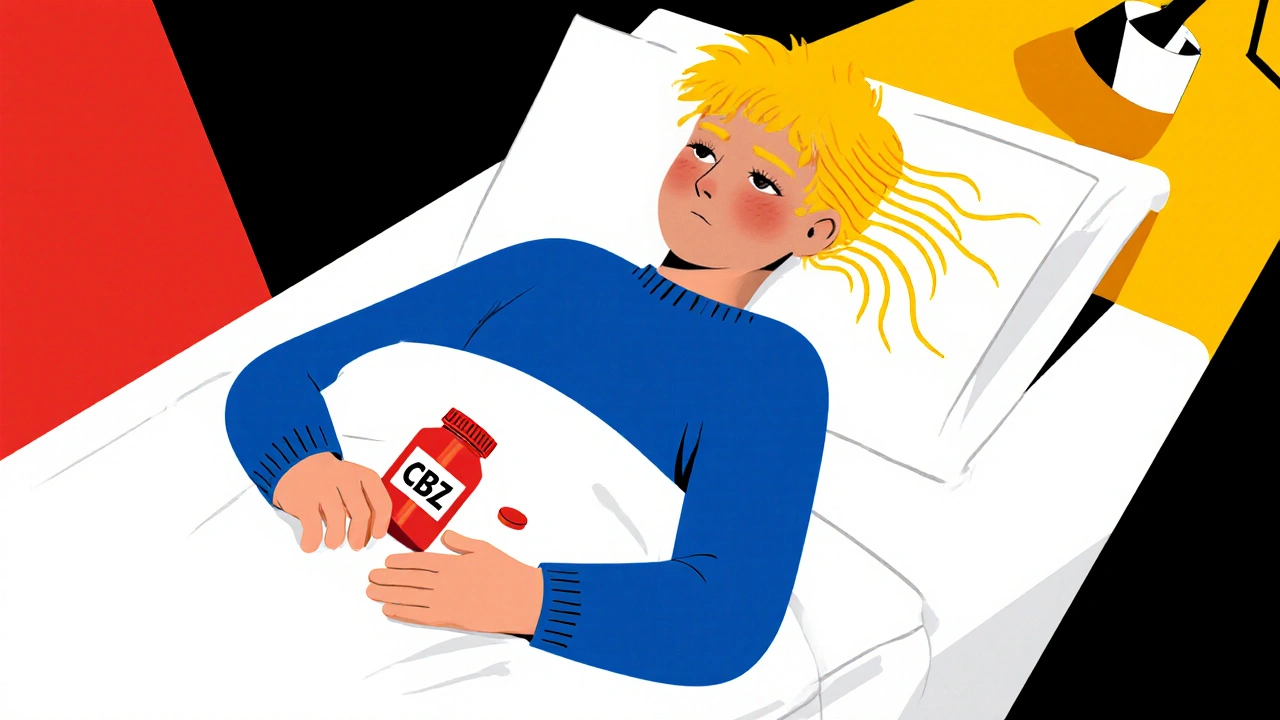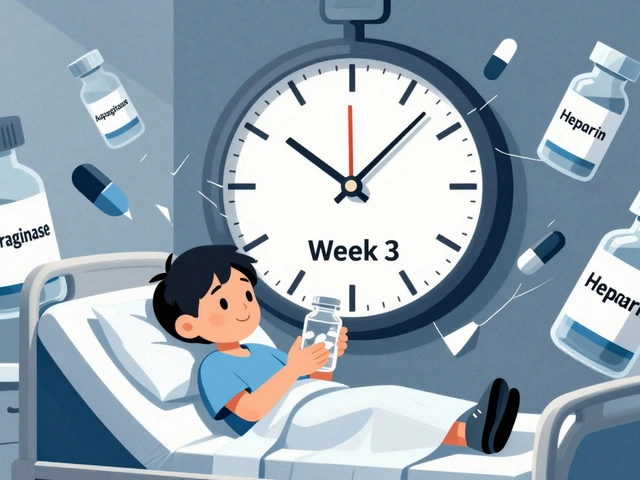
Carbamazepine Hair Loss Risk Calculator
Calculate Your Risk
Answer these questions to determine your risk level for hair loss while taking carbamazepine.
If you’ve been prescribed Carbamazepine a sodium‑channel blocker used for epilepsy and bipolar disorder and notice more strands on your pillow, you’re not alone. Hair loss is a frustrating side effect that can make you doubt whether the medication is worth it. This guide walks through why carbamazepine can cause hair shedding, who’s most likely to be affected, and what you can do to stop or reverse the problem without stopping treatment abruptly.
Key Takeaways
- Carbamazepine can trigger hair loss through hormonal shifts, nutrient depletion, and immune reactions.
- Risk rises for people with a family history of alopecia, nutritional deficiencies, or who combine carbamazepine with other hair‑loss‑prone drugs.
- Early detection, gentle hair care, and targeted supplements often keep shedding under control.
- Switching to an alternative medication should be a joint decision with your prescriber, based on seizure control and side‑effect profile.
What Is Carbamazepine?
Approved by the FDA in the 1960s, carbamazepine belongs to the class of sodium channel blockers. By stabilizing hyper‑excitable neuronal membranes, it reduces the frequency of seizures in epilepsy and helps temper mood swings in bipolar disorder. Typical doses range from 200 mg to 1200 mg per day, split into two or three doses.
How Carbamazepine Can Lead to Hair Loss
Hair follicles are surprisingly sensitive to changes in the body’s internal environment. Three main pathways explain the link between carbamazepine and hair loss also called alopecia, a condition where hair shafts shed faster than they grow:
- Hormonal disruption: Carbamazepine induces hepatic enzymes (especially CYP3A4) that accelerate the breakdown of sex hormones. Lower estrogen or testosterone levels can push more follicles into the telogen (resting) phase, leading to diffuse shedding.
- Nutrient depletion: The drug can cause mild folate and zinc loss through increased urinary excretion. Both nutrients are essential for keratin synthesis; a shortfall weakens the hair shaft.
- Immune‑mediated reactions: In rare cases, carbamazepine triggers a hypersensitivity response (e.g., Stevens‑Johnson syndrome). Even sub‑clinical inflammation around the scalp can damage the follicle bulge, resulting in spotty hair loss.
Who Is Most at Risk?
Not everyone on carbamazepine will lose hair, but certain factors raise the odds:
- Genetic predisposition: A family history of alopecia or androgenetic alopecia makes follicles more vulnerable.
- Existing nutrient gaps: Low baseline folate, vitamin D, or zinc.
- Concurrent medications: Drugs like valproic acid, oral contraceptives, or isotretinoin can amplify hormone shifts.
- Age and gender: Women in their 20s‑30s and men over 40 often notice pattern‑related thinning that carbamazepine can exacerbate.

Spotting Early Signs
Hair loss usually begins 4-12 weeks after starting carbamazepine, but it can appear later if dosages increase. Watch for:
- Increased shedding during washing or combing.
- Thinning at the crown or temples.
- Dry, itchy scalp that feels tighter than usual.
If you notice any of these clues, act quickly - early intervention yields better results.
Prevention Strategies
Before you panic, try these low‑risk steps that often stop the hair‑loss train:
- Optimize nutrition: A daily multivitamin containing 400 µg folic acid, 15 mg zinc, and 1000 IU vitamin D can offset the drug’s depletion effects.
- Gentle hair care: Swap harsh shampoos for sulfate‑free formulas, limit heat styling, and avoid tight ponytails that tug on fragile follicles.
- Stress management: Chronic stress raises cortisol, which also pushes follicles into telogen. Mindfulness, short walks, or yoga can keep cortisol in check.
- Regular blood work: Ask your doctor to monitor folate, zinc, and liver enzymes every 3-6 months.
Managing Hair Loss If It Happens
When prevention isn’t enough, treatment options fall into three buckets:
Topical and Cosmetic Solutions
- Minoxidil 2%-5%: Over‑the‑counter foam applied twice daily can prolong the anagen (growth) phase.
- Low‑level laser therapy (LLLT): Devices like combs or caps emit red light that stimulates cellular metabolism in the follicle.
Medical Interventions
- Finasteride (for men): Blocks dihydrotestosterone (DHT), a hormone that shrinks follicles.
- Spironolactone (for women): Offers anti‑androgen effects, useful when hormonal imbalance is the main driver.
- Corticosteroid injections: For localized inflammatory alopecia, a dermatologist may inject triamcinolone to reduce inflammation.
Adjusting the Medication
Never stop carbamazepine abruptly - seizures can rebound. However, dose reduction or switching to a less hair‑loss‑prone alternative (e.g., lamotrigine, levetiracetam) may be appropriate. This decision should involve:
- Reviewing seizure control records.
- Assessing side‑effect burden.
- Considering a slow cross‑taper over 4-6 weeks.

Alternatives and Risk Comparison
| Medication | Primary Indication | Reported Hair‑Loss Incidence | Mechanism Linked to Hair Loss |
|---|---|---|---|
| Carbamazepine | Partial seizures, bipolar disorder | ~8 % (clinical surveys) | Hormone metabolism, folate depletion |
| Lamotrigine | Generalized seizures, bipolar depression | ~2 % | Less impact on CYP enzymes |
| Levetiracetam | Broad‑spectrum epilepsy | ~1 % | Minimal hormonal effect |
| Valproic acid | Seizures, migraine prophylaxis | ~5 % | Weight gain, androgen increase |
| Oxcarbazepine | Partial seizures | ~3 % | Similar to carbamazepine but milder |
While carbamazepine carries the highest reported rate, many patients stay on it because it controls seizures better than alternatives. The table helps you discuss trade‑offs with your neurologist.
When to Call Your Healthcare Provider
Immediate medical attention is needed if you notice any of the following:
- Rapid, patchy hair loss accompanied by scalp redness or blistering (possible Stevens‑Johnson syndrome).
- Hair loss exceeding 100 strands per day for more than two weeks.
- New neurological symptoms (e.g., worsening seizures) after changing the dose.
Otherwise, schedule a routine check‑in to review labs, discuss supplement plans, and evaluate whether a dose tweak might help.
Quick Checklist for Managing Carbamazepine‑Related Hair Loss
- Track shedding: count strands lost during a typical wash.
- Start a daily multivitamin with folic acid, zinc, and vitamin D.
- Switch to sulfate‑free shampoo; avoid tight hairstyles.
- Set a blood‑test reminder every 4 months.
- Discuss minoxidil or laser therapy with a dermatologist if shedding persists beyond 3 months.
- Consider medication review only after consulting your neurologist.
Frequently Asked Questions
Can carbamazepine cause permanent hair loss?
Permanent loss is rare. In most cases, stopping the drug or treating the side effect allows hair to regrow within 6-12 months.
Should I stop carbamazepine if I start losing hair?
Never stop abruptly. Talk to your prescriber first. A dose reduction or a planned switch can be safer than quitting cold turkey.
Are there any foods that help counteract carbamazepine‑related hair loss?
Foods rich in folate (leafy greens, beans), zinc (pumpkin seeds, oysters), and vitamin D (fatty fish, fortified dairy) support healthy hair follicles.
Is minoxidil safe to use while on carbamazepine?
Yes. Minoxidil works locally on the scalp and does not interact systemically with carbamazepine.
How long does it take for hair to grow back after stopping the drug?
Hair typically re‑enters the anagen phase within 2-3 months, with noticeable regrowth by 6 months. Individual rates vary based on age and genetics.
Understanding the why behind carbamazepine‑related hair loss puts you in control. With the right labs, a few lifestyle tweaks, and a solid conversation with your doctor, you can keep both seizures and strands under control.








11 Comments
I've seen quite a few patients on carbamazepine get freaked out when the pillow starts looking like a hair clinic. The drug messes with hormones and can sap your folate and zinc, which are the building blocks for strong strands. The good news is that most of the shedding is temporary and can be tamed with a multivitamin and gentle hair care. Keep an eye on the timeline – if the loss is still climbing after a couple of months, it’s time to loop in your neurologist.
From a pharmacological standpoint, the CYP3A4 induction by carbamazepine is a textbook example of how enzyme up‑regulation precipitates endocrine perturbations, ultimately driving follicles into the telogen phase. In the American clinical setting we observe a non‑trivial incidence of alopecia that often gets brushed under the rug due to inadequate lab monitoring. The solution lies in a systematic approach: baseline serum zinc and folate, quarterly hepatic panels, and a pre‑emptive prescription of topical minoxidil. Neglecting these steps is tantamount to abandoning evidence‑based practice in favor of anecdotal tolerability.
Don't stress, your strands will bounce back! 😊
Carbamazepine’s interaction with the hepatic microsomal enzyme system is not merely a footnote in the pharmacokinetic textbook; it is the central driver of a cascade that can culminate in diffuse telogen effluvium. When the enzyme CYP3A4 is induced, the catabolism of circulating estradiol and testosterone accelerates, leading to a relative hypo‑estrogenic or hypo‑androgenic state that pushes a larger proportion of hair follicles into the resting phase. Simultaneously, the drug’s propensity to increase urinary excretion of zinc and folate deprives the keratinocytes of essential cofactors required for robust hair shaft formation. The clinical manifestation of these biochemical derangements is often a noticeable increase in hair shed during washing, roughly 4‑12 weeks after initiating therapy, aligning with the anagen‑telogen transition timeline. Importantly, the severity of the alopecia correlates with baseline nutritional status; patients already marginal on folate or zinc exhibit a steeper slope of hair loss. Moreover, concurrent medications that also modulate CYP enzymes-such as oral contraceptives or certain antifungals-can amplify this effect through additive enzyme induction. From a therapeutic perspective, the first line of defense is preventive: a daily supplement containing at least 400 µg of folic acid, 15 mg of elemental zinc, and 1,000 IU of vitamin D can offset the depletion. Complementary measures include switching to a sulfate‑free shampoo, minimizing heat styling, and avoiding traction hairstyles that could exacerbate mechanical shedding. If, after three months of optimized supplementation, the shedding persists above a threshold of 100 hairs per wash, a dermatologist should be consulted for adjunctive treatments such as topical minoxidil 5 % or low‑level laser therapy. If the hair loss is accompanied by scalp erythema or systemic symptoms, an immunologically mediated reaction, possibly a subclinical Stevens‑Johnson spectrum, must be ruled out urgently. Finally, any consideration of dose reduction or a cross‑taper to an alternative antiepileptic such as lamotrigine should be undertaken only after a comprehensive seizure control assessment, as abrupt changes can precipitate breakthrough seizures. In sum, while carbamazepine‑induced alopecia is a multifactorial phenomenon, a structured regimen of nutritional support, vigilant monitoring, and targeted topical therapy can preserve both neurological stability and cosmetic confidence. Patients should also be encouraged to keep a simple shedding diary, noting the number of strands lost per wash, to provide objective data for their physician. Regular blood work every four to six months will help catch any emerging deficiencies before they translate into visible hair loss. Ultimately, the goal is to strike a balance where seizure control is uncompromised while the aesthetic side effects remain manageable.
Think of hair as a resilient garden; even if a few weeds appear, proper care can coax it back to bloom. A balanced diet rich in leafy greens, nuts, and oily fish supplies the nutrients your follicles crave. Gentle scalp massage every evening can boost circulation and reassure you that you’re actively nurturing your hair. Remember, patience is a virtue-most people see regrowth within half a year if they stay consistent.
i totally agree w/ you, the nutrients r key. tho i found that sometimes even when u take the vitamins u still lose hair for a while. maybe its just the body adjusting to the med. its kinda weird but i think staying calm helps.
Honestly, the whole carbamazepine hair fiasco is a dramatized spectacle that only fuels panic. One must understand that the drug's efficacy in seizure control outweighs a temporary cosmetic inconvenience. If you’re truly obsessed with every strand, perhaps consider an alternative, but don’t let vanity dictate medical decisions.
While efficacy matters, dismissing legitimate side effects undermines patient trust. Addressing alopecia with supplements and topical agents is a pragmatic compromise.
What they don't tell you is that the pharma giants are secretly testing carbamazepine on millions just to see how many will lose hair and buy expensive shampoos. It's all part of a bigger plan to keep us dependent on their products. Wake up, folks.
Interesting angle! 🤔 But I'd love to see some solid studies before jumping to conclusions.
For clinicians looking to mitigate carbamazepine‑related alopecia, consider implementing a protocol that includes baseline serum folate, zinc, and vitamin D levels, followed by bi‑monthly monitoring. Initiate a high‑potency multivitamin regimen (400 µg folic acid, 15 mg zinc, 2,000 IU vitamin D) concomitant with the antiepileptic. Topical 5 % minoxidil has demonstrated a 30 % increase in hair density over a 24‑week period in retrospective analyses. In patients with inflammatory scalp findings, a short course of intralesional triamcinolone (10 mg/ml, 0.1 ml per cm²) can attenuate follicular inflammation. Lastly, when dose reduction is clinically feasible, a gradual cross‑taper to lamotrigine or levetiracetam may further reduce hormonal perturbations without compromising seizure control.